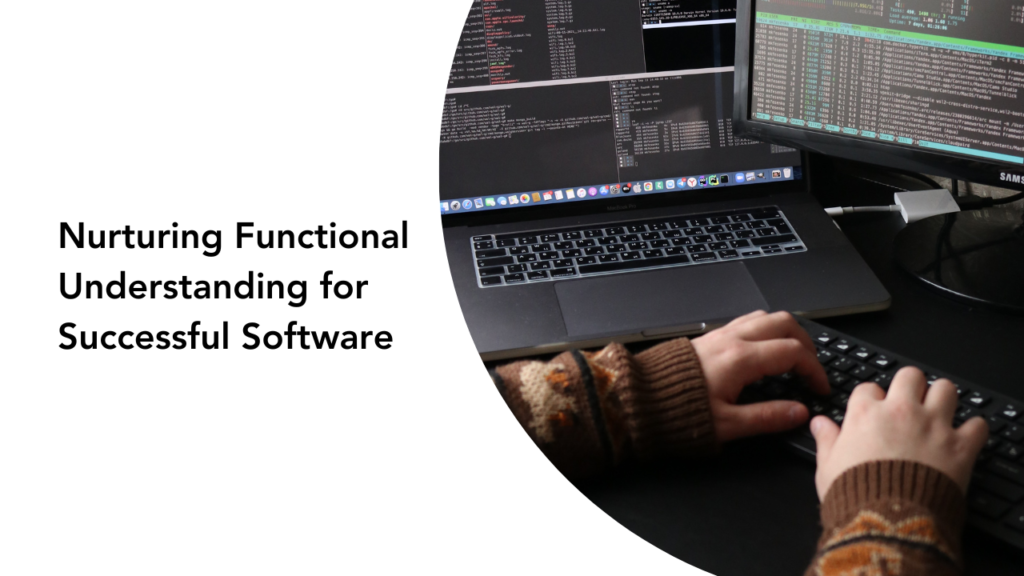
Introduction
As technology continues to advance at a rapid pace, software developers face the constant challenge of keeping up with new programming languages, frameworks, and methodologies. In order to stay relevant and succeed in the ever-evolving software industry, a strong grasp of functionality is equally pivotal in the realm of software development.
By understanding functionality, developers can ensure that the software they create aligns with user expectations and functions optimally.
This article aims to explore the importance of functional understanding and provide valuable insights into how it can be nurtured throughout the software development process.
Principles of Functional Understanding
Let’s see the four functional understandings needed to build creative and successful software.
Identifying user needs and requirements: This involves gathering insights from end-users to gain insights into their expectations, pain points, and desired features, which then guide the creation of products or services that effectively address these needs, ensuring customer satisfaction and product success.
Translating requirements into functional specifications: Once user needs and requirements are identified, it is essential to translate them into comprehensive functional specifications. These specifications serve as a blueprint for developing and implementing software functionality in a manner that aligns with the desired outcomes.
Implementing functional specifications effectively: With well-defined functional specifications, developers can implement the software functionality efficiently. This involves coding the software in the most optimal way, adhering to best practices, and ensuring that the software behaves as the users envision.
Testing and validating software functionality: To achieve successful software, thorough testing and validation are imperative. By rigorously testing the software using various real-life scenarios and user interactions, developers can ensure that the functionality meets the desired requirements and performs reliably.
Building a Strong Foundation for Functional Understanding
Gaining domain knowledge: Domain knowledge is consequential in developing a deep functional understanding.
Understanding the industry, its challenges, and the target audience’s needs allows developers to create software that solves specific problems effectively.
Exploring relevant programming languages and frameworks: Having knowledge of different programming languages and frameworks like algorithms, data structures, and object-oriented programming concepts expands a developer’s toolkit and enables them to choose the most suitable tools for each project.
This exploration broadens your capabilities and allows for more adept implementation of functional specifications.
Learning best practices in software design: Adopting best practices in software design ensures that the software is crafted with efficiency, maintainability, and scalability in mind.
Developers should continuously educate themselves on industry-standard approaches to design, such as modular and object-oriented programming, to develop software solutions that are robust and adaptable.
The Role of Communication in Functional Understanding
Communication is the main key to achieving functional understanding. It facilitates the exchange of information and ideas between individuals or teams, helping to clarify objectives, requirements, and expectations.
Effective communication ensures that all stakeholders share a common understanding of a project’s functionality, reducing misunderstandings, errors and enhancing collaboration for successful outcomes.
The Impact of Functional Understanding on User Satisfaction
- User-centric design principles
- Enhancing the user experience through functional understanding
- Measuring user satisfaction and feedback
Overcoming Challenges in Developing Functional Understanding
Dealing with ambiguous requirements: Ambiguous requirements can hinder functional understanding. Developers need to proactively address ambiguity by seeking clarification from stakeholders and leveraging their own expertise to propose viable solutions.
By actively collaborating and seeking clarification, developers can overcome the challenges associated with ambiguous requirements.
Addressing scope creep and changing priorities: Scope creep and shifting priorities can impact functional understanding. Developers must be adaptable and effectively manage changing requirements to maintain a clear understanding of the software’s functional goals.
Regular communication, evaluation, and adjustment of functional specifications facilitate successful software development in dynamic environments.
Managing conflicts and competing viewpoints: Conflicts and competing viewpoints among stakeholders can obscure functional understanding. Developers should facilitate constructive discussions and actively listen to varying perspectives to identify common ground and shared objectives.
By managing conflicts effectively, developers can maintain a strong functional understanding and ensure successful software development.
Conclusion
Gaining insights into functional understanding is a cornerstone of successful software development. It involves clear communication, active engagement with diverse perspectives, and a commitment to continuous learning and adaptation.
By prioritizing functional understanding throughout the development process, software teams can build solutions that not only meet user needs but also evolve to stay relevant in a dynamic digital landscape. Ultimately, this approach fosters innovation, enhances user satisfaction, and leads to software that stands the test of time.
If you have any questions, send me an email, and I’ll be pleased to respond.
